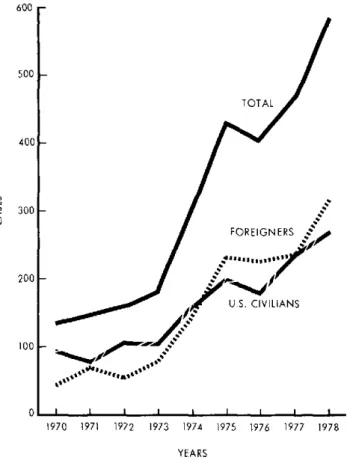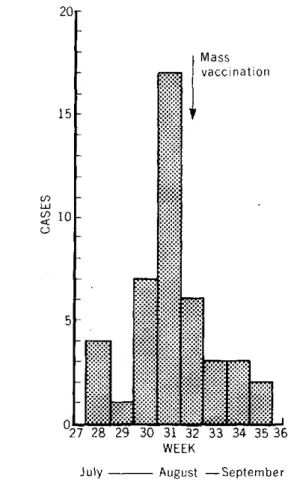Figure 2. Cases of malaria in U.S. civilians and foreigners, United States, 1970-1978.
600
r-500
¡-TOTAL
400
1-v>
te
u 300
J-quarter increase in the United States and foreign civilian cases between 1977 and 1978 brought the number to 585.
However, the percentage distribution of cases, by pur-pose of travel in malarious areas, has shown no appreci-able change in the past 10 years.
The 1978 data show that, of the American and foreign civilians who acquired malaria, most were students and teachers (23.7 per cent), but tourists (9 per cent) and businessmen (7.4 per cent) also accounted for a signifi-cant proportion of cases.
The distribution of cases by age and sex shows that, as in earlier years, males between 20 and 29 years of age accounted for the largest number of cases.
(Based on Malaria Surveillance Annual Summary 1978, Center for Disease Control, Atlanta, Georgia. Published in August 1979.)
200
1-U.S. CIVILIANS
100
--o I 1 i I i i i
1970 1971 1972 1973 1974 1975 1976 1977 1978 YEARS
Outbreak of Meningococcal Meningitis in Osorno, Chile
rIn mid-July 1979, an epidemic outbreak of menin-gococcal meningitis occurred in the city of Osorno and peaked in the following month. Following a mass vac-cination campaign carried out in mid-August, the out-break was brought under control (see Figure). A total of 39 cases was reported, which represents a rate of 21.7 per 100,000 inhabitants, compared with a rate of 1.1 per 100,000 recorded in nonepidemic years.;
The age groups most affected were u4weaned and school age children (Table 1).
Most of the cases occurred in the suburb of Rahue
Alto in the city of Osorno. In the remainder of the Province of Osorno,* which consists mostly of rural areas, only 7 cases occurred, which represents a rate of 3.9 per 100,000 inhabitants.
Of the 39 cases recorded in the Province of Osorno, 31 were confirmed bacteriologically by culture, and typing showed that all were due to strain A. In 6 cases; the diagnosis was made by Gram staining of
cerebro-*In Chile, the Province of Osorno must be distinguished from the provincial capital of Osorno.
9
Table 1. Distribution of meningococcal meningitis cases by age-group, Osorno, Chile, 1979.
Age (in years)
0-1 2-5 6-10 11-15 20 and over Not recorded
Total
No. of cases %
II 5 8 4 9 2
28.2 12.8 20.5 10.3 23.1 5.1
39 100.0
Table 2. Mass meningococcal vaccination, August 1979.
Osorno, Chile,
Program Area <5 years 6-18 years Total %
Urban 10,856 44,964 55.820 98 Rural 6.903 21,297 28.200 92
Total 17,759 66.261 84,020 96
spinal fluid; in 2, it was based on clinical symptoms. Of the strains isolated, 57 per cent proved resistant to the sulfonamide.
The case fatality rate was 15.4, and almost all the deaths (5 out of 6) occurred in children under 2 years of age.
Mass vaccination was carried out for a period of three days (14, 15, and 16 August) among the total popula-tion aged 2-18 years of the Province; polyvalent menin-gococcal vaccine A and C prepared by the Merieux Institute was used.
Furthermore, all direct contacts of the cases were treated for 4 days with rifampin, adults receiving 600 mg daily, 5-12 year-old children 300 mg daily, and those younger than 5 years of age 20 mg daily per kg of body weight.
cn iu
o-c
Weekly incidence of meningococcal meningitis, Osorno,
Chile, 1979.
WEEK
July - August -September
Epidemiological surveillance subsequent to the vac-cination campaign made it possible to confirm 8 ad-ditional cases in the following weeks, but no further cases were detected thereafter.
(Source: Government of Chile, Ministry of Public Health, Vigilancia de enfermedades transmisibles y zoonosis 6 (10), October, 1979.)
Vitamin D Intoxication in Venezuela
l In June 1979, two rural families in Carabobo State shared a 5-liter drum of oil containing 2 million IU of vitamin D3per gram.
In the course of 6 weeks, 16 persons consumed food prepared with this oil. At the end of approximately 1
month, the first symptoms appeared: vomiting, ano-rexia, progressive loss of weight (an average of 16 kg), irritation of eyes, dizziness, and, in some cases, a sharp pain in the lower extremities.JOf the 4 children in-volved, 2 were unable to walk, one had difficulty in
10
l
i
I
1 ? y
-'r._11

